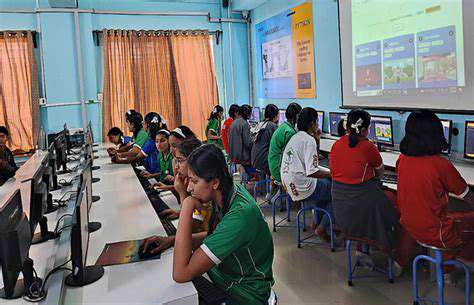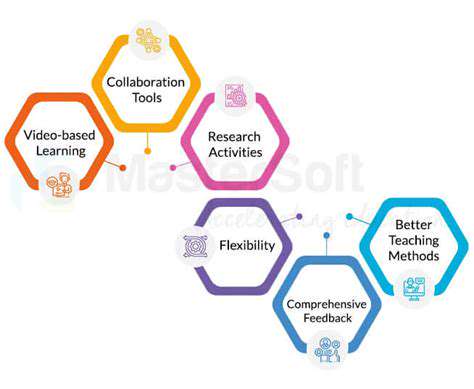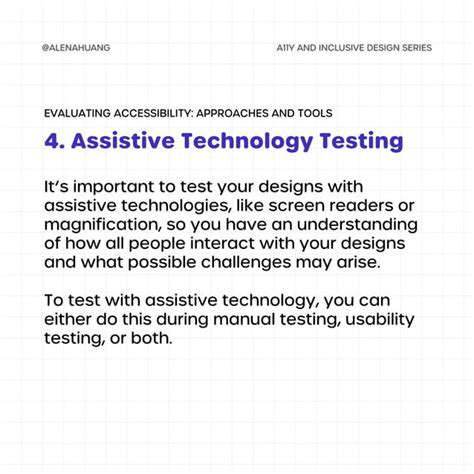The Impact of Mobile Learning on Global STEM Education
Democratizing STEM Education Through Mobile Devices
Bridging the Accessibility Gap
Mobile devices offer unprecedented opportunities to democratize STEM education by overcoming geographical and socioeconomic barriers. Students in remote areas or underserved communities, previously excluded from high-quality STEM instruction, now have access to interactive learning materials, simulations, and virtual labs. This accessibility fosters a more inclusive learning environment, ensuring that STEM education is no longer limited to those with privileged access to traditional resources.
Enhancing Engagement and Motivation
Interactive mobile learning apps and games can significantly enhance student engagement and motivation in STEM subjects. These tools often employ gamification techniques, creating a fun and rewarding learning experience that keeps students actively involved in the material. The dynamic nature of mobile learning platforms can cater to diverse learning styles, making complex concepts more digestible and memorable for a wider range of students.
Personalized Learning Experiences
Mobile learning platforms can tailor educational content to individual student needs and learning paces. Adaptive learning algorithms analyze student performance and provide personalized recommendations for further study, ensuring that every student receives targeted support and guidance. This personalized approach can significantly improve student outcomes and foster a deeper understanding of STEM concepts.
Facilitating Collaboration and Communication
Mobile devices facilitate collaboration and communication among students, educators, and even experts in the field. Online forums, collaborative projects, and real-time feedback mechanisms create a vibrant learning environment where students can share ideas, ask questions, and work together on projects. This collaborative aspect of mobile learning promotes critical thinking, problem-solving, and teamwork skills, all crucial elements of STEM education.
Expanding Access to Real-World Applications
Mobile devices provide access to a wealth of real-world STEM applications and data. Students can use mobile apps to collect and analyze data from the environment, interact with scientific instruments, and connect with professionals in the field. This connection with real-world applications helps students understand the practical implications of STEM concepts and motivates them to pursue further study and careers in these fields.
Developing 21st-Century Skills
Mobile learning promotes the development of crucial 21st-century skills such as critical thinking, problem-solving, digital literacy, and adaptability. Students are encouraged to explore, experiment, and innovate within the dynamic mobile learning environment. These skills are highly valued in today's rapidly changing world, preparing students for success in STEM careers and beyond.
Cost-Effectiveness and Scalability
Compared to traditional methods of STEM instruction, mobile learning often proves to be a more cost-effective and scalable solution. Digital resources and learning platforms can be distributed widely and updated frequently, reducing the need for expensive physical materials and ongoing instructional expenses. This cost-effectiveness and scalability make mobile learning a valuable tool for reaching a wider population and improving educational access on a global scale.

Expanding Access to Quality STEM Resources

Bridging the Gap in STEM Education
Access to quality science, technology, engineering, and mathematics (STEM) education is crucial for fostering innovation and economic growth. Unfortunately, disparities exist in access, often linked to socioeconomic factors, geographic location, and underrepresentation of certain demographics. Addressing these disparities is critical to ensure that all students have the opportunity to develop the necessary skills and knowledge to thrive in a rapidly evolving world.
Promoting Equitable Opportunities
A key component of expanding STEM access involves actively promoting equitable opportunities for all students. This includes implementing targeted programs and initiatives that address the unique needs of underrepresented groups, such as providing mentorship and support from STEM professionals, offering scholarships and financial aid, and creating inclusive learning environments.
By actively promoting these opportunities, we can foster a more diverse and inclusive STEM ecosystem. This approach not only benefits individual students but also enriches the field as a whole by bringing diverse perspectives and experiences to the forefront.
Investing in Teacher Development
High-quality STEM education relies heavily on well-prepared and enthusiastic teachers. Investing in professional development opportunities for educators is paramount. These programs should equip teachers with the knowledge and skills to effectively teach complex STEM concepts, incorporate innovative teaching methods, and inspire a passion for STEM learning in their students. This investment in teacher training will have a profound impact on the quality of STEM education across the board.
Creating Inclusive Learning Environments
A supportive and inclusive learning environment is essential for all students, particularly those from underrepresented backgrounds. This includes fostering a sense of belonging, addressing potential biases, and creating a safe space for students to ask questions, explore their interests, and take risks. A strong emphasis on collaboration and teamwork is also vital in fostering a positive learning atmosphere.
Utilizing Technology for Accessibility
Technology plays a powerful role in bridging the gap in STEM education. Online resources, interactive simulations, and virtual labs can make STEM learning more engaging, accessible, and affordable for students in underserved communities. Utilizing technology to create personalized learning pathways can cater to diverse learning styles and needs, further enhancing the effectiveness of STEM education.
Fostering Public-Private Partnerships
Collaborations between public institutions, private companies, and community organizations are essential to drive STEM education initiatives effectively. These partnerships can provide valuable resources, mentorship programs, and internship opportunities for students. Such collaborations can also leverage the expertise and resources of the private sector to further enhance STEM education programs and create lasting impact.
Fostering Engagement and Motivation Through Interactive Learning
Enhancing Knowledge Retention
Interactive learning platforms often incorporate gamification elements, such as points, badges, and leaderboards, which can significantly boost engagement and motivation. These elements provide a sense of accomplishment and competition, encouraging learners to actively participate and strive for progress. This active participation, in turn, strengthens their understanding and retention of the material, as they are actively processing information rather than passively receiving it. This active engagement leads to a deeper understanding and a more meaningful learning experience.
Furthermore, interactive learning often allows for immediate feedback, which plays a crucial role in identifying and addressing knowledge gaps promptly. This immediate reinforcement cycle is vital for solidifying comprehension and reducing the likelihood of misconceptions, ultimately leading to more effective knowledge acquisition and retention.
Personalized Learning Experiences
Interactive learning platforms offer a unique opportunity to tailor the learning experience to individual needs and preferences. By adapting to the pace and style of each learner, these platforms can create a more inclusive and supportive environment. This personalized approach not only increases engagement but also fosters a sense of ownership and control over the learning process, leading to increased motivation and a more positive learning outcome. Personalized learning also allows for a deeper understanding of individual strengths and weaknesses.
Moreover, learners can often choose their preferred learning modality (visual, auditory, kinesthetic) within interactive platforms, enhancing their overall learning experience. This personalized approach caters to diverse learning styles, ensuring that each learner finds a method that best suits their cognitive preferences. This tailored approach is key to maximizing the potential of the learning experience.
Promoting Active Participation
Interactive learning methods, such as simulations, quizzes, and collaborative activities, encourage active participation from the learners. This active engagement is crucial for transforming passive reception of information into an active process of knowledge construction. This active participation fosters deeper understanding and retention, as learners are directly involved in the learning process, not just passively absorbing information.
Interactive exercises and games provide opportunities for learners to apply their knowledge in a practical setting. This hands-on approach to learning strengthens comprehension and allows learners to connect theoretical concepts to real-world scenarios, creating a more meaningful and engaging learning experience. This active participation is essential to the overall learning process.
Boosting Motivation and Engagement
The dynamic nature of interactive learning often fosters a sense of excitement and intrigue among learners. The inclusion of various multimedia elements, such as videos, audio clips, and interactive simulations, makes learning more engaging and enjoyable. This increased engagement can lead to higher levels of motivation and a more positive attitude towards learning.
The opportunity to interact with peers and instructors in a virtual environment can also contribute to a stronger sense of community and belonging. This social interaction fosters a supportive learning environment where learners feel encouraged to ask questions and share their ideas. This sense of community is crucial for creating a supportive and stimulating learning environment.
Improving Accessibility and Inclusivity
Interactive learning platforms often offer features that enhance accessibility for learners with diverse needs. Features such as adjustable text sizes, audio descriptions, and closed captioning can make the learning experience more inclusive and accessible to a wider range of learners. This inclusivity fosters a sense of belonging and promotes equity in the learning process.
Furthermore, the flexibility and adaptability of interactive learning platforms allow for varied learning environments and paces. This adaptability can accommodate different learning styles and preferences, ensuring that all learners have the opportunity to engage with the material in a way that best suits their needs. This flexibility is crucial for creating a truly inclusive learning environment.
Read more about The Impact of Mobile Learning on Global STEM Education
Hot Recommendations
- Attribution Modeling in Google Analytics: Credit Where It's Due
- Understanding Statistical Significance in A/B Testing
- Future Proofing Your Brand in the Digital Landscape
- Measuring CTV Ad Performance: Key Metrics
- Negative Keywords: Preventing Wasted Ad Spend
- Building Local Citations: Essential for Local SEO
- Responsive Design for Mobile Devices: A Practical Guide
- Mobile First Web Design: Ensuring a Seamless User Experience
- Understanding Your Competitors' Digital Marketing Strategies
- Google Display Network: Reaching a Broader Audience











